#lone infantryman on Omaha Beach
Photo


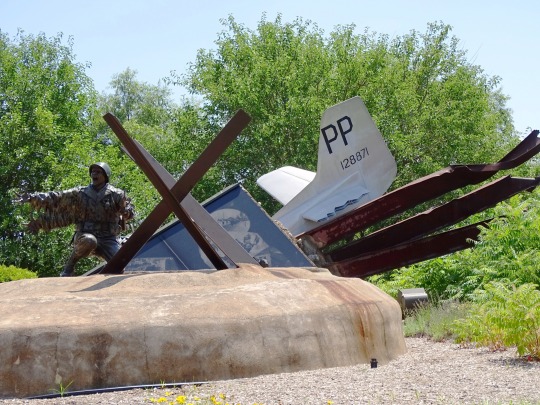
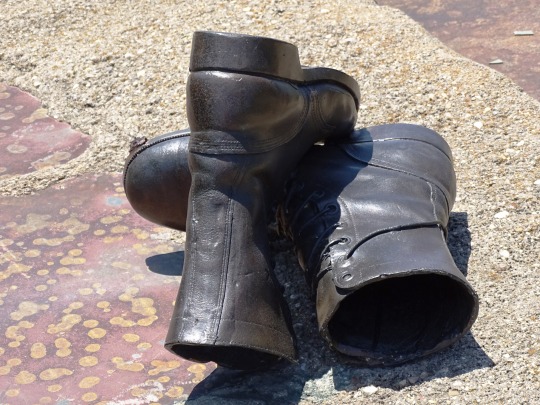
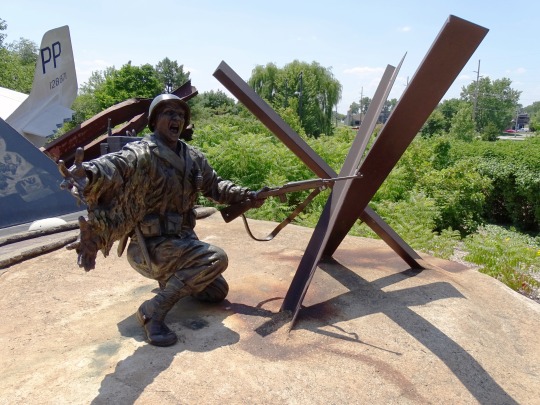



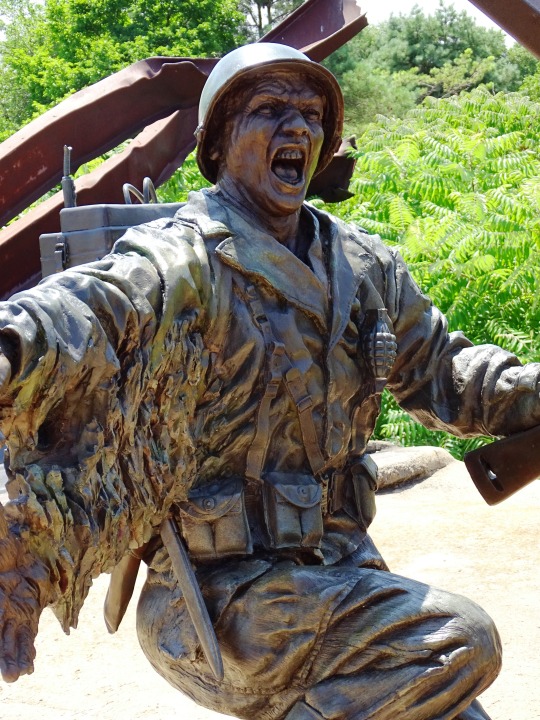
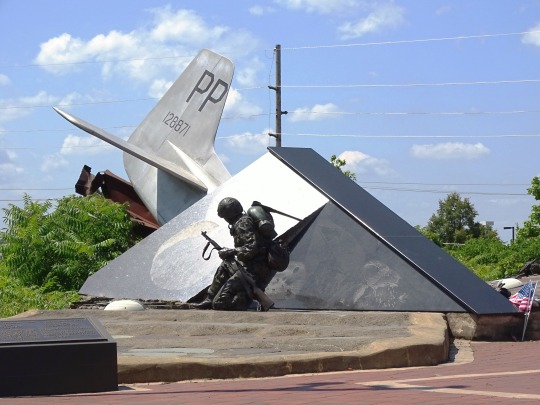
World War II: Nazi Germany and Slovakia invaded Poland, beginning the European phase of World War II on September 1, 1939.
#World War II#Nazi Germany#invaded#Poland#begin#start#WWII#1 September 1939#anniversary#history#Munster#summer 2019#travel#free admission#Community Veterans Memorial#Indiana#original photography#impressive#World War Two#lone infantryman on Omaha Beach#Home Front Monument by Omri Amrany#Pacific Monument
2 notes
·
View notes
Photo
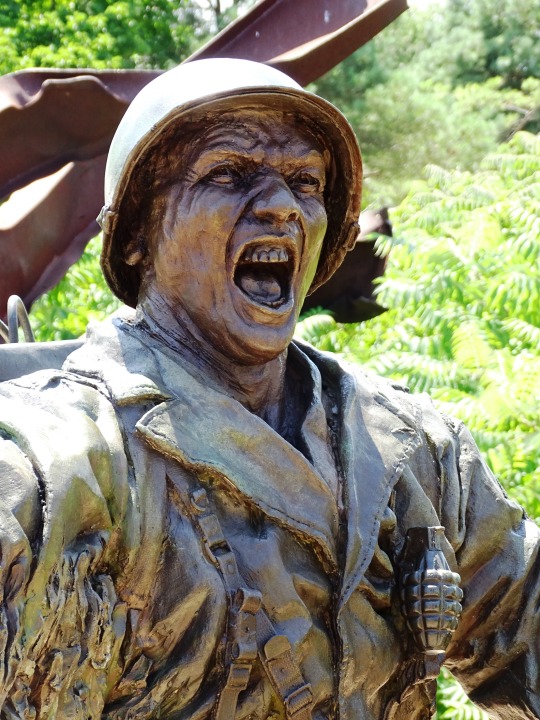


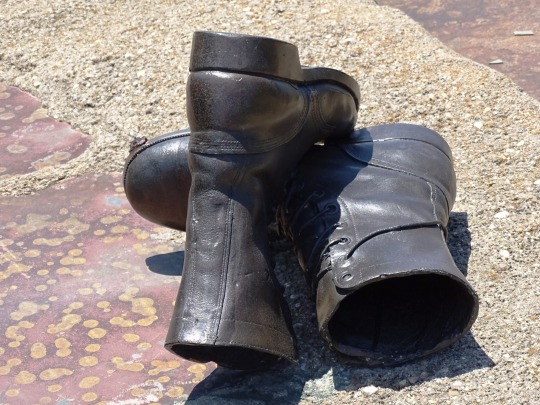




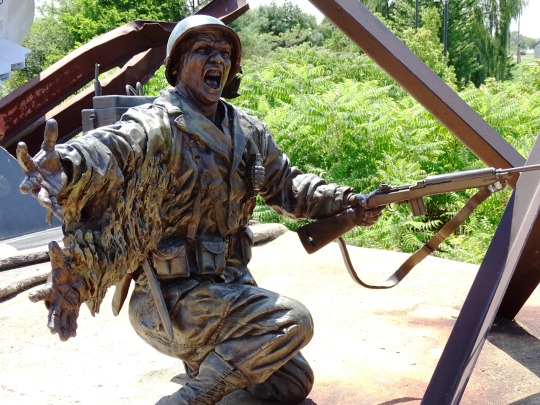
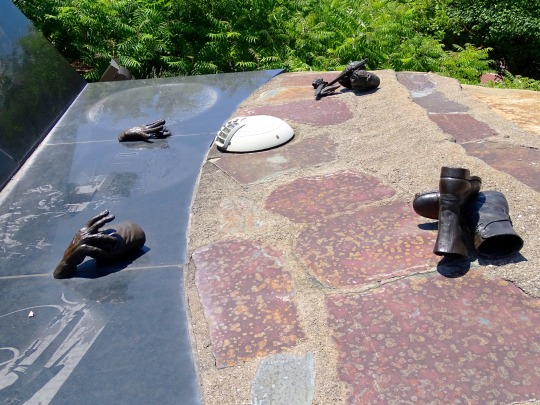
Victory in Europe Day
Victory in Europe Day is observed on May 8 to commemorate when the Allies of World War II formally accepted Germany’s unconditional surrender of its armed forces. Did you know that even after Germany — the architect of the war — surrendered, Japan continued to wage war against the Allied troops? World War II was the costliest war ever; over 75 million lives were lost, cities leveled, and the economy of Europe was devastated. The war began when Hitler’s Germany invaded Poland and ended nearly six years later when Japan surrendered. Victory in Europe Day is celebrated as a public holiday in several European countries and termed V.E. Day and V-E Day in the U.K. and the U.S., respectively.
HISTORY OF VICTORY IN EUROPE DAY
On April 30, 1945, the Allied forces surrounded Germany, tightening the noose around the German army. Realizing the hopelessness of his situation, Hitler killed his newly wedded wife, Eva Braun, and committed suicide in his Berlin bunker. Immediately taking the presidency, Grand Admiral Karl Donitz, Hitler’s successor, began negotiating for a term of surrender with the Allied forces. Chief among his goals was saving as many Germans as possible from being captured by the Soviets.
On May 4, in Luneburg Heath, British Field Marshal Bernard Montgomery accepted the unconditional surrender of German forces in the Netherlands, northwest Germany, and Denmark. On May 7, another unconditional military surrender was signed at SHAEF H.Q. at Reims, between Supreme Allied Commander General Eisenhower and General Alfred Jodl of Germany. The following day, a slightly modified document — the definitive German Instrument of Surrender — was signed in Karlshorst, Berlin, by German Field Marshal William Keitel.
Following the announcement of the German surrender on radio on May 7, the news quickly spread across the western world, and jubilations erupted everywhere, especially in North America and the U.K. The B.B.C. interrupted their program to announce that Victory in Europe Day would be a national holiday. Over one million people trooped out to the streets of the U.K. to celebrate, while in London, people crowded Trafalgar Square, the Mall, and Buckingham Palace. The British Royal Family, joined by Prime Minister Winston Churchill, appeared on the palace’s balcony, waving to the cheering crowds.
In the United States, Victory in Europe Day happened to be the same day as President Harry Truman’s 61st birthday. However, he dedicated the victory to his late predecessor, Franklin D. Roosevelt and the U.S. flag remained at half-mast. Victory in Europe Day was also celebrated in Australia, Paris, and Canada — where a riot broke down and resulted in several deaths.
VICTORY IN EUROPE DAY TIMELINE
April 30,1945 The Suicide of Hitler
During the Battle of Berlin, the city becomes surrounded — so, Hitler kills his wife and commits suicide.
May 4, 1945 The First Act of Surrender
British Field Marshal Bernard Montgomery accepts the unconditional surrender of German forces in the Netherlands, northwest Germany, and Denmark.
May 7, 1945 The Second Act of Surrender
Supreme Allied Commander General Eisenhower accepts the unconditional surrender of German forces from German General Alfred Jodl.
May 8, 1945The German Instrument of Surrender
The definitive German Instrument of Surrender is signed in Berlin by German Field Marshal William Keitel.
August 14, 1945 The End of the War
Japan agrees to surrender to the Allied forces and formally signs an agreement the following month.
VICTORY IN EUROPE DAY FAQS
Is Victory in Europe Day celebrated in Germany?
Victory in Europe Day is generally viewed in Germany as a day to commemorate those that died during the war. However, it’s also a day to renew their promises of preventing such events from happening again.
Who celebrates Victory in Europe Day?
Victory in Europe Day is mainly celebrated by North American and European countries, including Israel and the European Union — celebrated as Europe Day.
How do the French celebrate Victory in Europe Day?
Victory in Europe Day is celebrated with a lot of festivities and fanfare. Church services, parades, ceremonies, monument visitations, and air force flyovers are ways Victory in Europe Day is commemorated in France.
HOW TO OBSERVE VICTORY IN EUROPE DAY
Visit the World War II Memorial
Talk to a World War II veteran
Watch World War II movies or documentaries
The World War II Memorial was built in 2004 to honor those that fought and died during World War II. The memorial is located in Washington D.C. You can visit and take a tour around this place of honor to pay your respects to those that prevented the war from entering our borders.
You can observe Victory in Europe Day by chatting with a WWII veteran about the unfiltered events of the war. There are many of these veterans around, and they can be found at senior homes. Visiting them would allow you to learn a lot and provide you with an opportunity to appreciate them for their sacrifices.
Many films are produced almost every decade, dedicated to the major battles of World War II. You can spend Victory in Europe Day by watching classics like “Stalingrad,” “Dunkirk,” “Dirty Dozen,” “Come and See,” and “Saving Private Ryan.” You can also watch documentaries, such as “Battlefield,” “World At Watt,” and “Russia’s War: Blood Upon the Snow.”
5 IMPORTANT FACTS ABOUT WORLD WAR II
It was between two groups of countries
The Holocaust happened
Some countries remained neutral
It was the bloodiest war
Millions died for not being perfect Germans
World War II was fought between Allied countries — Britain, France, Russia, China, and the U.S. — and Axis nations — Germany, Italy, and Japan.
Hitler’s Germany killed about six million Jewish people during the war.
Spain, Sweden, and Switzerland are examples of countries that never chose a side during the war.
About 75 million people died during the war, including 40 million civilians and 20 million military personnel.
Aside from Jews, Hitler ordered people with disabilities and Gypsies to be killed for not meeting his vision of the best and strongest race.
WHY VICTORY IN EUROPE DAY IS IMPORTANT
It marked the beginning of the end of WWII
It serves as a day of remembrance
It’s a day of reflection
When the German forces surrendered to the Allied troops on Victory in Europe Day, it ended the war on the European theatre, allowing the Allies to concentrate their efforts to win in the Eastern theatre three months later.
Victory in Europe Day is not only a day to celebrate Germany’s surrender but also a day to appreciate the military personnel that fought and died to make it happen.
Victory in Europe Day is a day for every country that participated in World War II, both the instigators and heroes, to reflect on the actions and events that led to the outbreak of war and ensure they don’t repeat themselves.
Source
#lone infantryman on Omaha Beach#Community Veterans Memorial#Indiana#USA#Munster#very impressive#free admission#Omri Amrany#8 May 1945#Victory in Europe Day#European history#V-E Day#VictoryInEuropeDay#WWII#World War Two#World War II#Pacific Monument#Europe Monument#Midwestern USA#Great Lakes Region#original photography#summer 2019#tourist attraction#landmark
1 note
·
View note
Photo

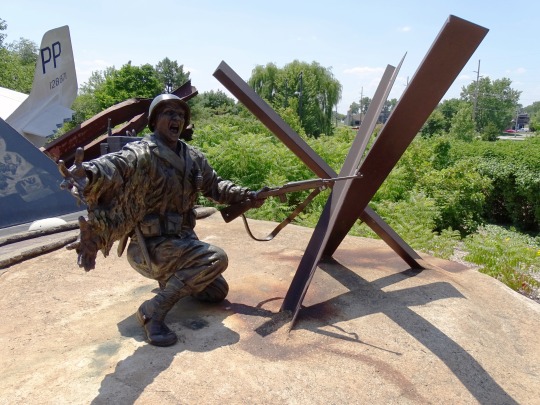
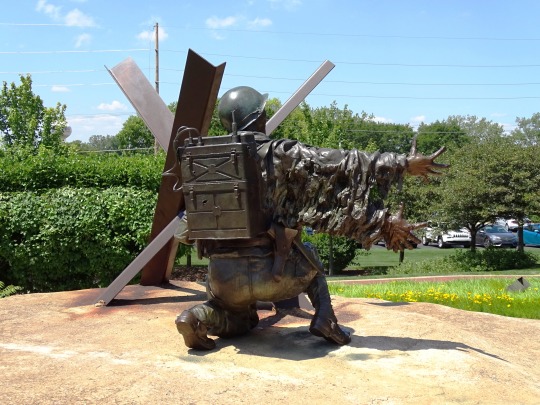


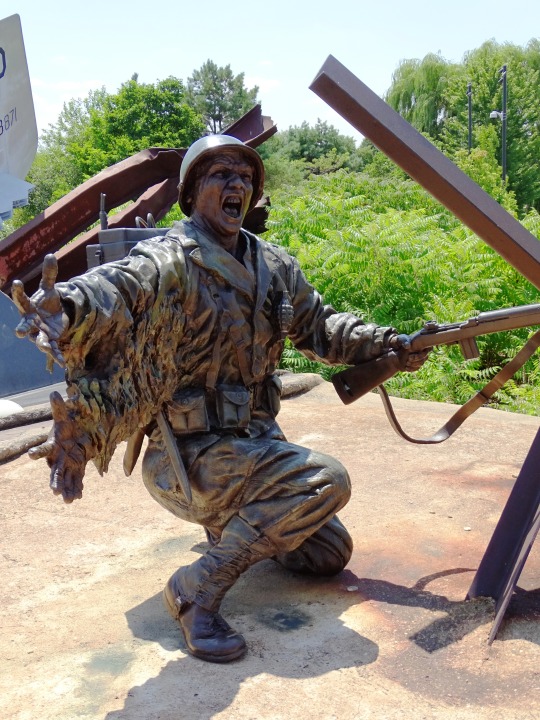

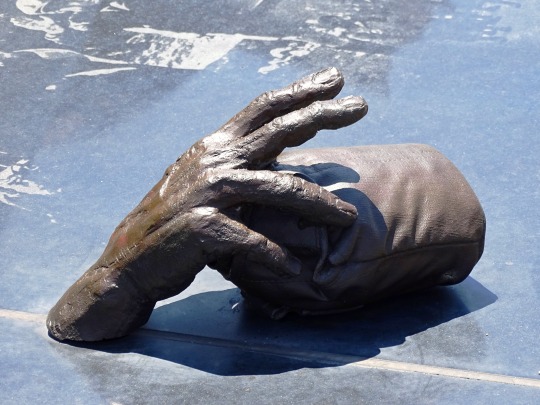
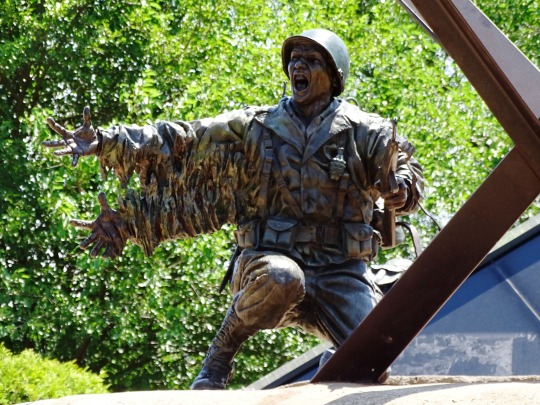

D-Day
Beginning in the spring of 1940, in the midst of World War II, Nazi Germany started occupying the northern part of France. They gained complete control of the area in May, when the British evacuated Dunkirk, a coastal city, during the Battle of France. But the Allies always hoped to return. In 1942, the United States and Britain began thinking about an invasion across the English Channel. Hitler, anticipating an invasion somewhere—although he did not know exactly where—put Erwin Rommel in charge of defense of a large swath of coastal areas and in charge of the creation of an Atlantic Wall, which consisted of fortifications of bunkers, landmines, and other beach and water obstacles.
The Allies codenamed their amphibious invasion of Normandy “Operation Overlord,” and placed Gen. Dwight D. Eisenhower in charge of it in January 1944. The invasion became known as D-Day, and its implementation would prove to be the start of the end of the war. The more obvious choice for the invasion was Pas de Calais, the spot with the shortest distance between Britain and Continental Europe. In fact, a deception campaign prior to D-Day made the Germans think that Pas de Calais—as well as Norway and some other locations—would be areas of invasion. Deception tactics included the use of fake equipment, George S. Patton’s phantom army—which was supposedly stationed across from Pas de Calais, fraudulent radio transmissions, and double agents. The beaches of Normandy were chosen instead because they were less heavily defended than Pas de Calais, but were still within air cover.
D-Day was originally scheduled for June 5, but it was pushed back a day due to bad weather. Eisenhower told his troops, “You are about to embark upon the Great Crusade, toward which we have striven these many months. The eyes of the world are upon you.” Five thousand ships, 13,000 aircraft, and over 160,000 American, British, and Canadian troops readied for invasion.
Airborne operations started in the early morning hours of June 6, preceding the amphibious landing by about 5 hours. Over 13,000 paratroopers from the U.S. 82nd and 101st Airborne Divisions, the British 6th Airborne Division, and the 1st Canadian Parachute Battalion were dropped behind enemy lines and worked to secure bridges and exit roads. An additional 4,000 men of the glider infantry landed using 500 gliders.
The amphibious landing took place over a 50 mile stretch of beachfront in Normandy, on the French coastline. There were five beaches where the landing took place. From west to east they were Utah, Omaha, Gold, Juno, and Sword. The Allies faced rather light resistance at all the beaches except Omaha. That beach was the most heavily defended of the five, and also had a difficult terrain consisting of bluffs and cliffs.
Although the Allies achieved their objective of gaining a foothold on the continent, it was not without heavy losses. By some estimates, over 4,000 Allied troops were killed, and another 5,000 or so troops were wounded. The beaches were secured by June 11, and over 326,000 troops had landed, as well as 50,000 vehicles and 100,000 tons of equipment. By the end of June, 850,000 Allied troops and 150,000 vehicles were on the continent. The Battle of Normandy lasted until late August when Paris was liberated and northern France was taken back from the Nazis. Preparations were then made to head towards Germany. The Germans were defeated in the Spring of 1945, and surrendered on May 8. All of this became possible because of the valiant efforts of those on D-Day! We remember them and their service and sacrifice today!
How to Observe
The day may be observed in a number of ways:
Visit the National D-Day Memorial in Virginia.
Visit The National WWII Museum in New Orleans.
Visit the Omaha Beach Memorial Museum on Omaha Beach.
Go to the Overlord Museum in Normandy, France.
Keep an eye out for events taking place at D-Day memorials and museums or at other locations.
Watch a feature film or documentary that focuses on D-Day.
View photos of D-Day.
Read a book on D-Day.
Source
#lone infantryman on Omaha Beach#Community Veterans Memorial#Munster#Indiana#huge#very impressive#free admission#tourist attraction#USA#landmark#Midwestern USA#public art#sculpture#6 June 1944#US history#anniversary#D-Day#Omri Amrany#WWII#World War Two#World War II#cityscape#vacation#travel#summer 2016
0 notes
Photo






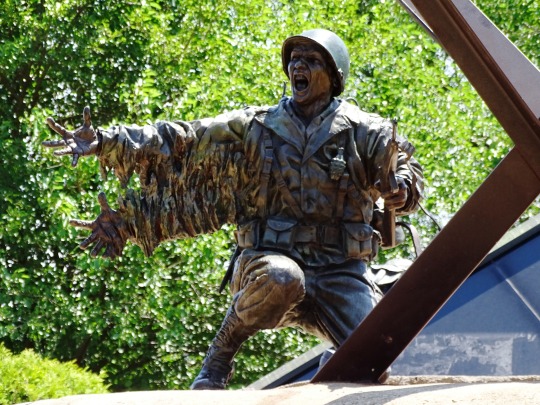



Victory in Europe Day
Victory in Europe Day, generally known as VE Day (United Kingdom) or V-E Day (US), is a day celebrating the formal acceptance by the Allies of World War II of Nazi Germany’s unconditional surrender of its armed forces on Tuesday, 8 May 1945, marking the end of World War II in Europe. VE Day is celebrated across Western European states on 8 May, with several countries observing public holidays on the day each year, variously called Victory Over Fascism Day, Liberation Day or simply Victory Day.
Russia, Belarus, and Serbia celebrate on 9 May, as do several former Soviet bloc countries. Israel also marks VE Day on 9 May, as a result of the large number of immigrants from the former Soviet bloc, although it is not a public holiday. The term VE Day existed as early as September 1944, in anticipation of victory.
Source
#lone infantryman on Omaha Beach#Victory in Europe Day#VE Day#V-E Day#8 May 1945#anniversary#history#original photography#Munster#USA#Community Veterans Memorial#free admission#Indiana#tourist attraction#Pacific Monument by Omri Amrany#impressive#WWII#World War Two#World War II#landmark#park#sculpture#public art
0 notes
Photo

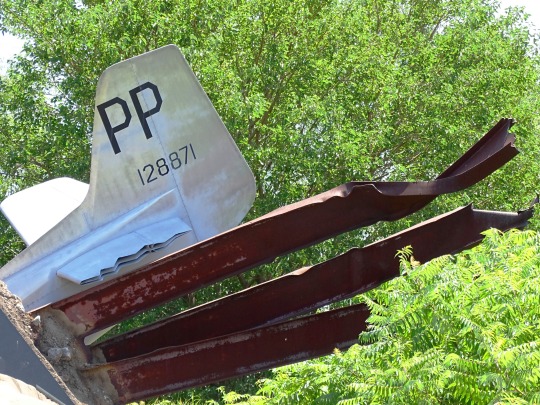



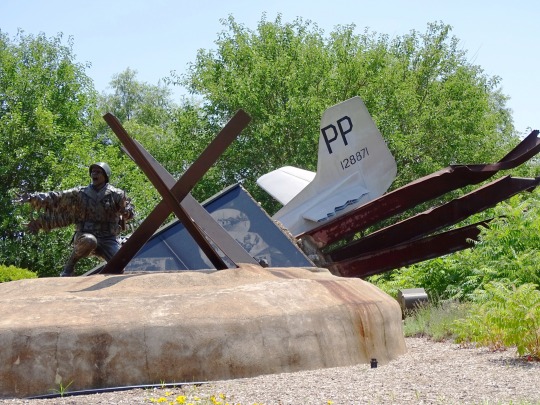




Europe/Pacific Monument, Community Veterans Memorial (No. 2)
I still remember/the sun-blown stench,
and the pit/At least two hundred yards from/The
cove we'd anchored guns in./They were blasting at
the mountains,/The beach was nearly ours.
Lucien Stryk, American Soldier Poet, The Pit
WORLD WAR II in the Pacific took everything we had. It stretched our Navy, Army, Marines, and Air Forces to distant Asian limits. It forced a new worldview, as it faced the Japanese military tyrant head on. The Pacific Monument presents the forces combining in the big picture and also captures an intimate moment.
Set against granite, repetitive lines fall away in pattern reminiscent of ocean, seamen, and battles. Remembering the courage of airmen, a P-51 is crashed, its tail section intact. Through an opening, a lone infantryman offers compassion.
Laser-etched over the Pacific Monument are photographic scenes we never want to forget At Pearl Harbor a rescue boat draws close to the burning U.S.S. West Virginia. At the Coral Sea the Lexington slides into the sea. At Midway the Yorktown succumbs hurt beyond pain. The tide turns as U. S. Navy divebombers put four Japanese carriers beneath the sea, during the Battle of Midway, the turning point in the Pacific War.
At Iwo Jima - with 25,000 casualties - Marines cling to the beach and the flag is raised on Mt. Suribachi. At Leyte Gulf through Okinawa, kamikaze suicide attacks proved a final Japanese weapon.
The Pacific Monument can only glimpse the vast story of that War. We see a soldier boy we know his duty, relief, and victory. We see him reach his hand in compassion.
Source
#Europe Monument by Omri Amrany#Community Veterans Memorial#Munster#Indiana#travel#vacation#summer 2019#huge#very impressive#USA#WWII#World War II#World War Two#US history#military history#D-Day#lone infantryman on Omaha Beach#haunting#Midwestern USA#Great Lakes Region#park#outdoors#tourist attraction#Pacific Monument#moving
4 notes
·
View notes
Photo
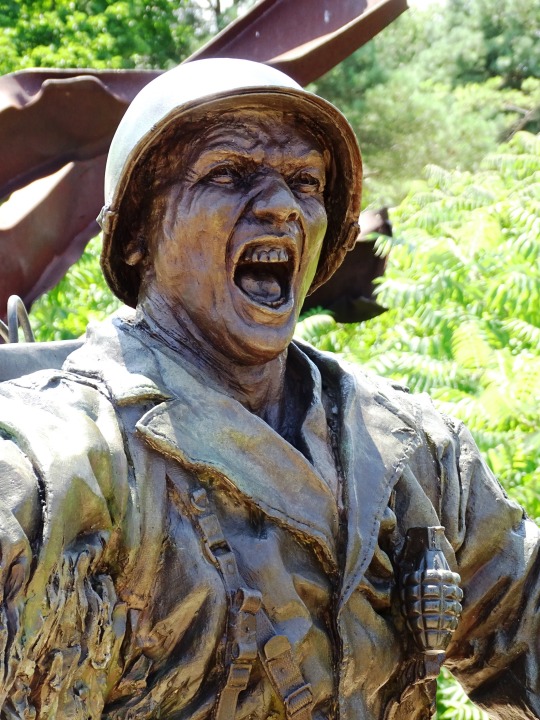
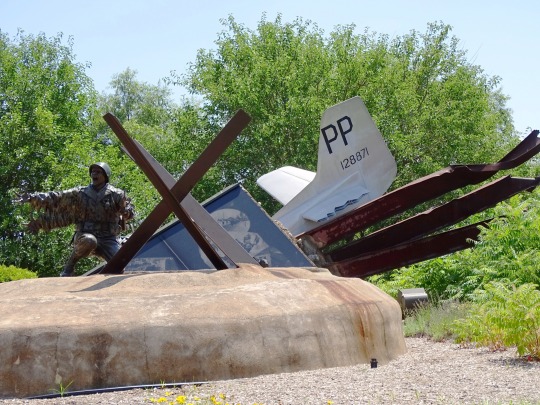





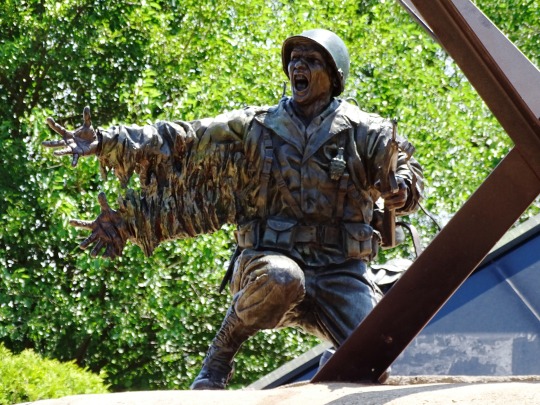
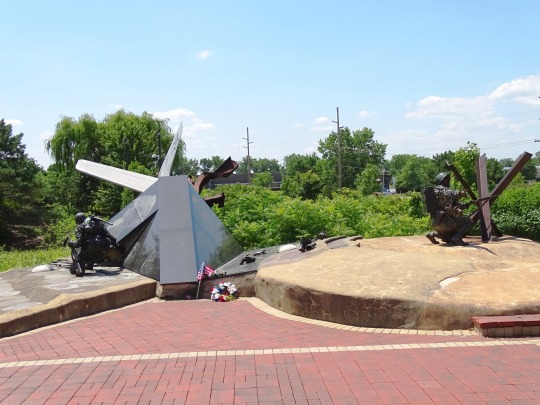

D-Day
Beginning in the spring of 1940, in the midst of World War II, Nazi Germany started occupying the northern part of France. They gained complete control of the area in May, when the British evacuated Dunkirk, a coastal city, during the Battle of France. But the Allies always hoped to return. In 1942, the United States and Britain began thinking about an invasion across the English Channel. Hitler, anticipating an invasion somewhere—although he did not know exactly where—put Erwin Rommel in charge of defense of a large swath of coastal areas and in charge of the creation of an Atlantic Wall, which consisted of fortifications of bunkers, landmines, and other beach and water obstacles.
The Allies codenamed their amphibious invasion of Normandy "Operation Overlord," and placed Gen. Dwight D. Eisenhower in charge of it in January 1944. The invasion became known as D-Day, and its implementation would prove to be the start of the end of the war. The more obvious choice for the invasion was Pas de Calais, the spot with the shortest distance between Britain and Continental Europe. In fact, a deception campaign prior to D-Day made the Germans think that Pas de Calais—as well as Norway and some other locations—would be areas of invasion. Deception tactics included the use of fake equipment, George S. Patton's phantom army—which was supposedly stationed across from Pas de Calais, fraudulent radio transmissions, and double agents. The beaches of Normandy were chosen instead because they were less heavily defended than Pas de Calais, but were still within air cover.
D-Day was originally scheduled for June 5, but it was pushed back a day due to bad weather. Eisenhower told his troops, "You are about to embark upon the Great Crusade, toward which we have striven these many months. The eyes of the world are upon you." Five thousand ships, 13,000 aircraft, and over 160,000 American, British, and Canadian troops readied for invasion.
Airborne operations started in the early morning hours of June 6, preceding the amphibious landing by about 5 hours. Over 13,000 paratroopers from the U.S. 82nd and 101st Airborne Divisions, the British 6th Airborne Division, and the 1st Canadian Parachute Battalion were dropped behind enemy lines and worked to secure bridges and exit roads. An additional 4,000 men of the glider infantry landed using 500 gliders.
The amphibious landing took place over a 50 mile stretch of beachfront in Normandy, on the French coastline. There were five beaches where the landing took place. From west to east they were Utah, Omaha, Gold, Juno, and Sword. The Allies faced rather light resistance at all the beaches except Omaha. That beach was the most heavily defended of the five, and also had a difficult terrain consisting of bluffs and cliffs.
Although the Allies achieved their objective of gaining a foothold on the continent, it was not without heavy losses. By some estimates, over 4,000 Allied troops were killed, and another 5,000 or so troops were wounded. The beaches were secured by June 11, and over 326,000 troops had landed, as well as 50,000 vehicles and 100,000 tons of equipment. By the end of June, 850,000 Allied troops and 150,000 vehicles were on the continent. The Battle of Normandy lasted until late August when Paris was liberated and northern France was taken back from the Nazis. Preparations were then made to head towards Germany. The Germans were defeated in the Spring of 1945, and surrendered on May 8. All of this became possible because of the valiant efforts of those on D-Day! We remember them and their service and sacrifice today!
How to Observe
The day may be observed in a number of ways:
Visit the National D-Day Memorial in Virginia.
Visit The National WWII Museum in New Orleans.
Visit the Omaha Beach Memorial Museum on Omaha Beach.
Go to the Overlord Museum in Normandy, France.
Keep an eye out for events taking place at D-Day memorials and museums or at other locations.
Watch a feature film or documentary that focuses on D-Day.
View photos of D-Day.
Read a book on D-Day.
Source
#lone infantryman on Omaha Beach#Munster#Indiana#WWII#World War II#World War Two#6 June 1944#US history#D-Day#Community Veterans Memorial#huge park#Omri Amrany#Europe Monument by Omri Amrany#impressive#travel#vacation#summer 2018#Midwestern USA#Great Lakes Region#tourist attraction#military history#anniversary
3 notes
·
View notes
Photo


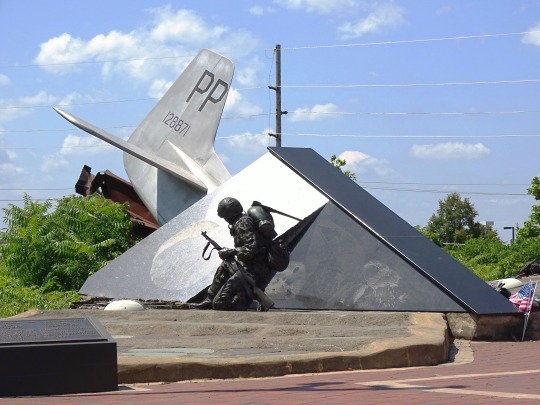
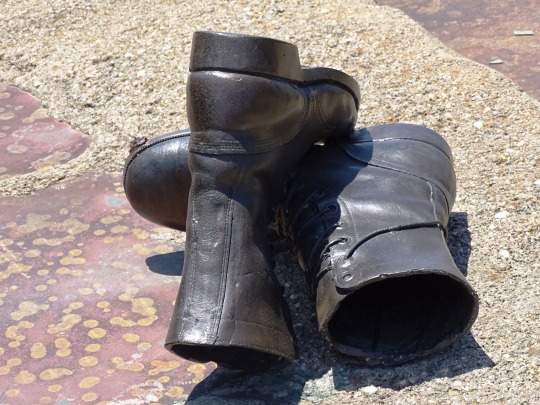


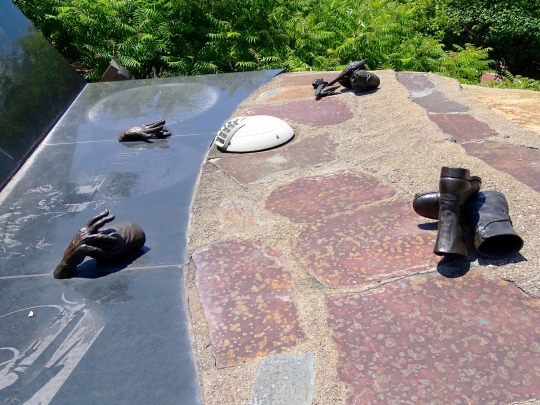


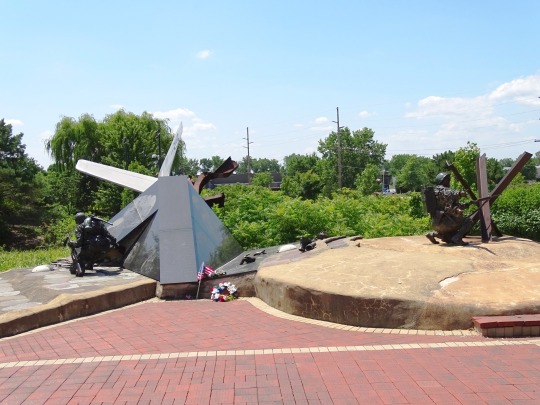
Europe Monument, Community Veterans Memorial (No. 1)
D-DAY The breaking of the Nazi 'Atlantic Wall' was led by General Dwight D. Eisenhower, supreme allied commander. At .15hrs 82nd and 101st airborne parachuted from DC3 aircraft. Following naval/air bombardment, 4th infantry at 6.30hrs assaulted Utah Beach-liberating Ste-mere Eglise. Also at 6.30hrs (4.30 by rangers), Omaha Beach was assaulted by 1st, 29th, and 116th infantry regiment. With rangers 2nd battalion at 5th and La Pointe Du Hoc, they are remembered for sacrificial heroism.
The Europe Monument is led with a lone infantryman on Omaha Beach. A bronze radioman' calls to all the others behind a steel 'hedgehog' he faces 'the dragon's teeth'.
The World War II Monument is the topographic peak of the Community Veterans Memorial.
It expresses new directions from Europe. The split steel beams represent destruction from World War I continued in Europe, to the Pacific - pointing to Korea and Vietnam. The circular motifs symbolize human enforcement on nature or waves of the sea. Designs are based on modern concepts of repetition to infinity.
Triangular granite slabs host laser-etched photos moments on Omaha Beach, horrific destruction at Monte Cassino, a B-24 Liberator, and Bastogne in the snowy Ardennes. From concentration camps, images remind us of the terrible 'Holocaust'.
With time's perspective, what new or old cry might our 'radioman' call out?
Source
#Europe Monument by Omri Amrany#Community Veterans Memorial#Munster#Indiana#huge#very impressive#tourist attraction#travel#vacation#USA#summer 2019#WWII#World War II#World War Two#Omaha Beach#D-Day#lone infantryman on Omaha Beach#haunting#Midwestern USA#Great Lakes Region#park#outdoors#military history#US history#Pacific Monument
1 note
·
View note
Photo



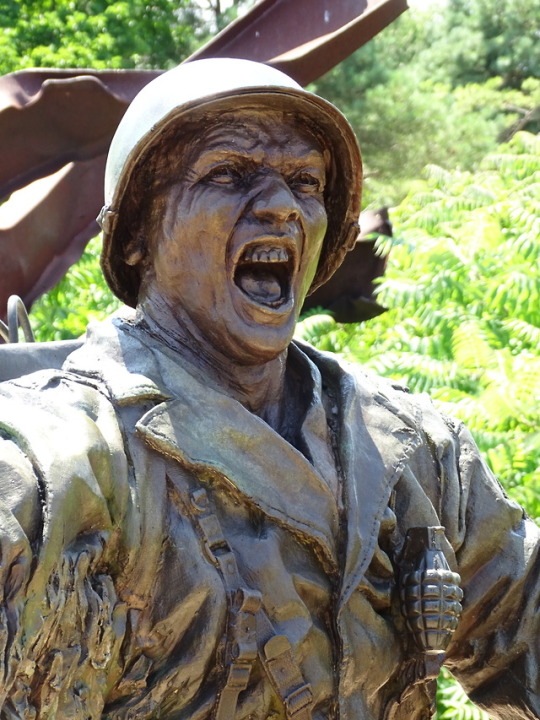


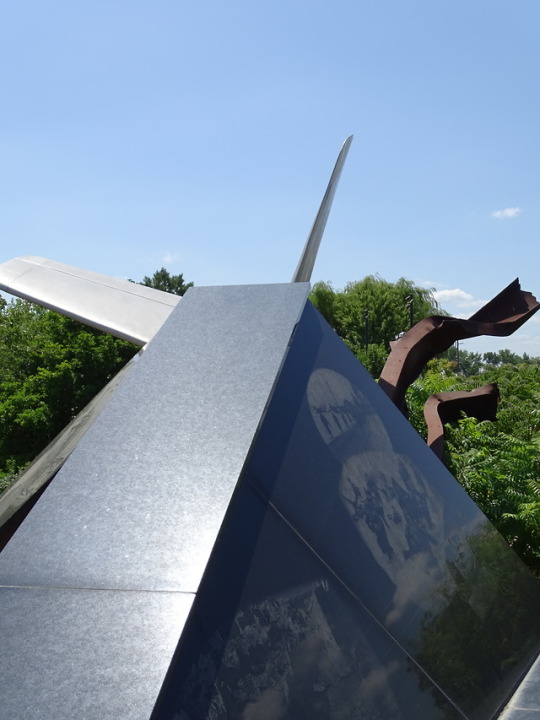
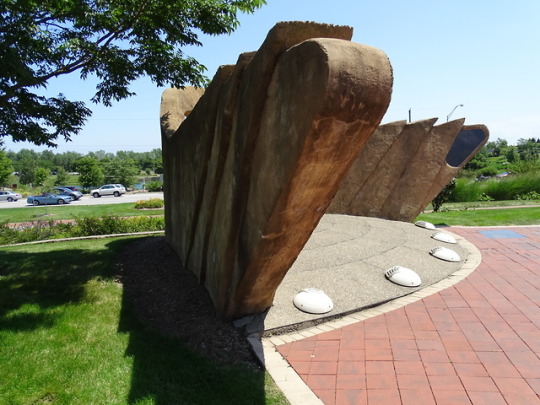


World War II: Nazi Germany and Slovakia invaded Poland, beginning the European phase of World War II on September 1, 1939.
#Community Veterans Memorial#Europe Monument by Omri Amrany#Munster#lone infantryman on Omaha Beach#Home Front Monument#Pacific Monument#World War II#WWII#start#1 September 1939#80th anniversary#history#Indiana#USA#travel#very impressive#summer 2019#vacation#road trip#cityscape
2 notes
·
View notes
Photo

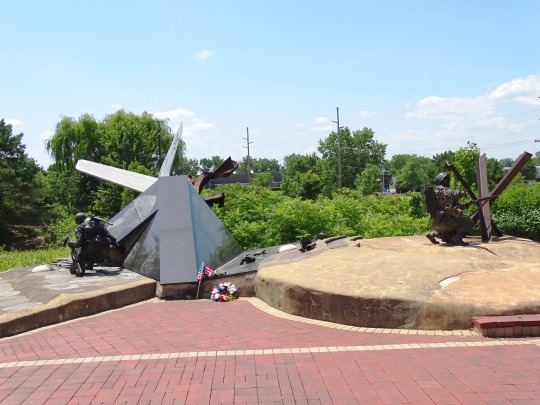

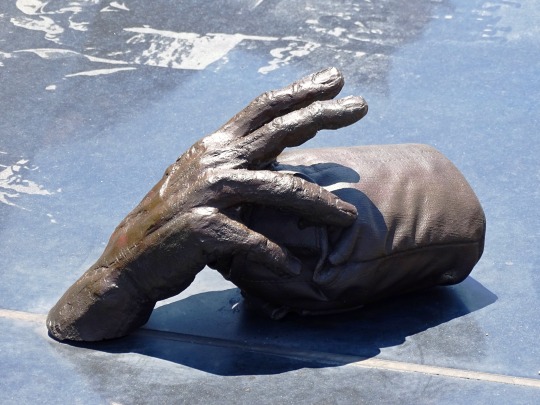

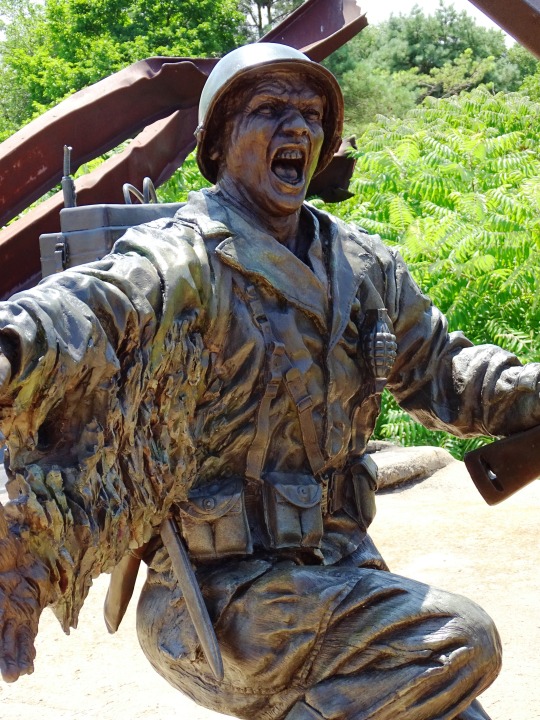
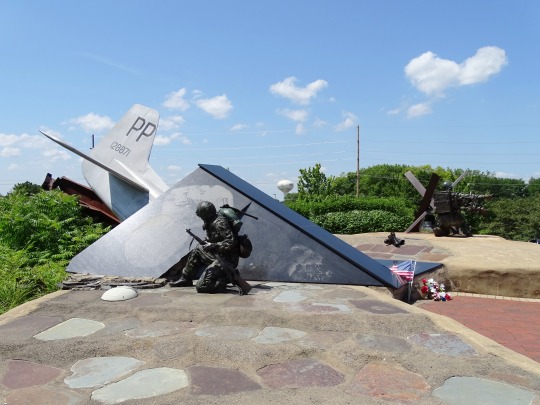



D-Day
Beginning in the spring of 1940, in the midst of World War II, Nazi Germany started occupying the northern part of France. They gained complete control of the area in May, when the British evacuated Dunkirk, a coastal city, during the Battle of France. But the Allies always hoped to return. In 1942, the United States and Britain began thinking about an invasion across the English Channel. Hitler, anticipating an invasion somewhere—although he did not know exactly where—put Erwin Rommel in charge of defense of a large swath of coastal areas and in charge of the creation of an Atlantic Wall, which consisted of fortifications of bunkers, landmines, and other beach and water obstacles.
The Allies codenamed their amphibious invasion of Normandy “Operation Overlord,” and placed Gen. Dwight D. Eisenhower in charge of it in January 1944. The invasion became known as D-Day, and its implementation would prove to be the start of the end of the war. The more obvious choice for the invasion was Pas de Calais, the spot with the shortest distance between Britain and Continental Europe. In fact, a deception campaign prior to D-Day made the Germans think that Pas de Calais—as well as Norway and some other locations—would be areas of invasion. Deception tactics included the use of fake equipment, George S. Patton’s phantom army—which was supposedly stationed across from Pas de Calais, fraudulent radio transmissions, and double agents. The beaches of Normandy were chosen instead because they were less heavily defended than Pas de Calais, but were still within air cover.
D-Day was originally scheduled for June 5, but it was pushed back a day due to bad weather. Eisenhower told his troops, “You are about to embark upon the Great Crusade, toward which we have striven these many months. The eyes of the world are upon you.” Five thousand ships, 13,000 aircraft, and over 160,000 American, British, and Canadian troops readied for invasion.
Airborne operations started in the early morning hours of June 6, preceding the amphibious landing by about 5 hours. Over 13,000 paratroopers from the U.S. 82nd and 101st Airborne Divisions, the British 6th Airborne Division, and the 1st Canadian Parachute Battalion were dropped behind enemy lines and worked to secure bridges and exit roads. An additional 4,000 men of the glider infantry landed using 500 gliders.
The amphibious landing took place over a 50 mile stretch of beachfront in Normandy, on the French coastline. There were five beaches where the landing took place. From west to east they were Utah, Omaha, Gold, Juno, and Sword. The Allies faced rather light resistance at all the beaches except Omaha. That beach was the most heavily defended of the five, and also had a difficult terrain consisting of bluffs and cliffs.
Although the Allies achieved their objective of gaining a foothold on the continent, it was not without heavy losses. By some estimates, over 4,000 Allied troops were killed, and another 5,000 or so troops were wounded. The beaches were secured by June 11, and over 326,000 troops had landed, as well as 50,000 vehicles and 100,000 tons of equipment. By the end of June, 850,000 Allied troops and 150,000 vehicles were on the continent. The Battle of Normandy lasted until late August when Paris was liberated and northern France was taken back from the Nazis. Preparations were then made to head towards Germany. The Germans were defeated in the Spring of 1945, and surrendered on May 8. All of this became possible because of the valiant efforts of those on D-Day! We remember them and their service and sacrifice today!
How to Observe
The day may be observed in a number of ways:
Visit the National D-Day Memorial in Virginia.
Visit The National WWII Museum in New Orleans.
Visit the Omaha Beach Memorial Museum on Omaha Beach.
Go to the Overlord Museum in Normandy, France.
Keep an eye out for events taking place at D-Day memorials and museums or at other locations.
Watch a feature film or documentary that focuses on D-Day.
View photos of D-Day.
Read a book on D-Day.
Source
#lone infantryman on Omaha Beach#Community Veterans Memorial#Munster#Indiana#D-Day#6 June 1944#World War Two#World War II#vacation#park#free admission#original photography#summer 2019#travel#USA#DDay#Pacific Monument#history#anniversary#public art#impressive#tourist attraction#landmark#D Day
0 notes